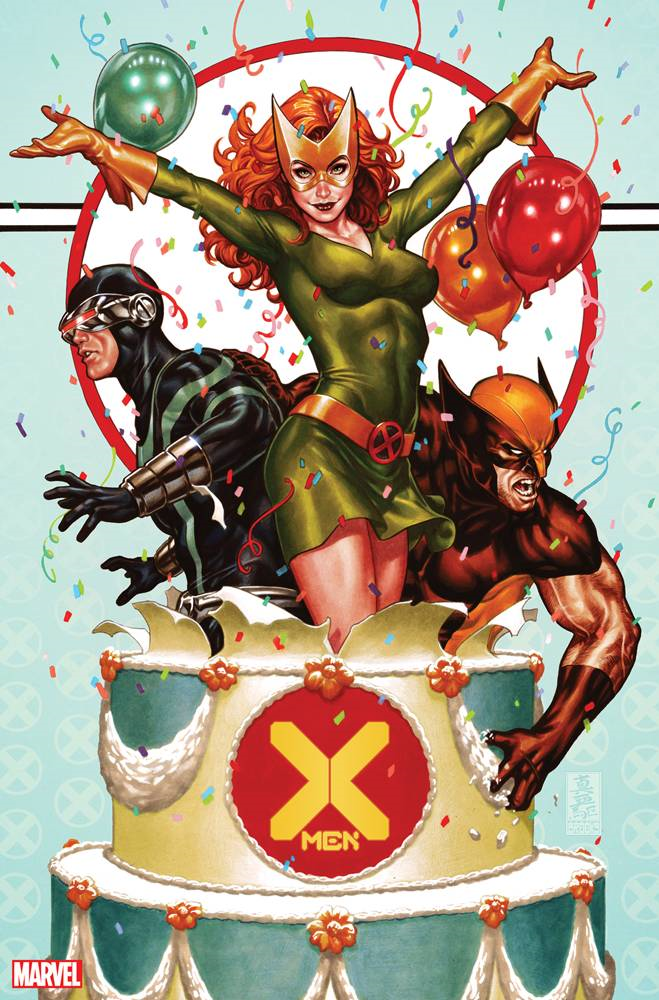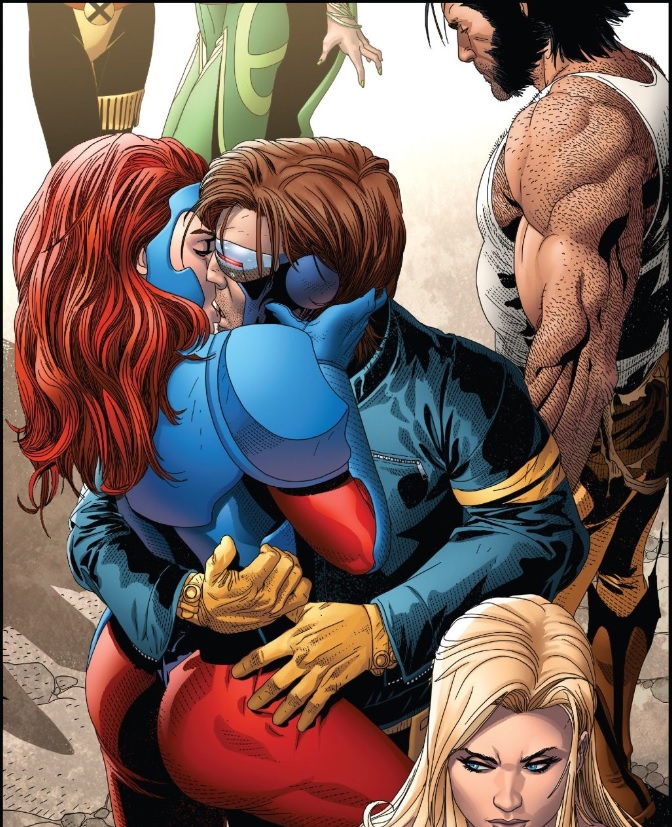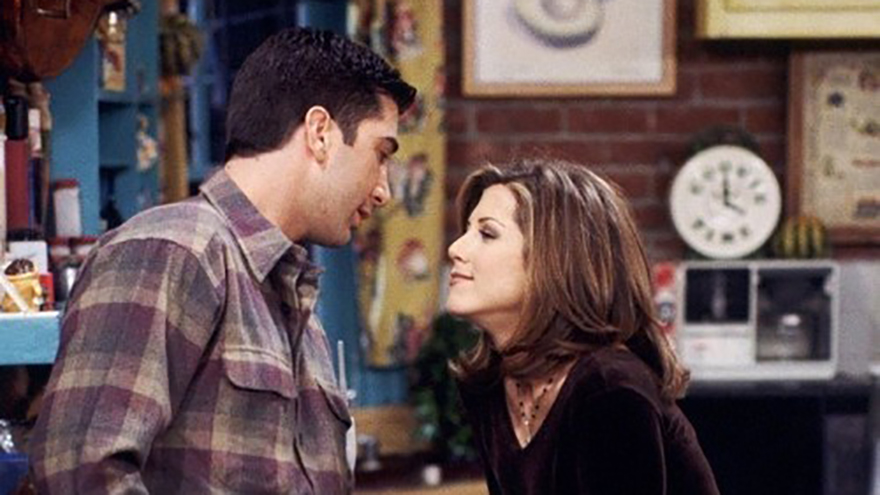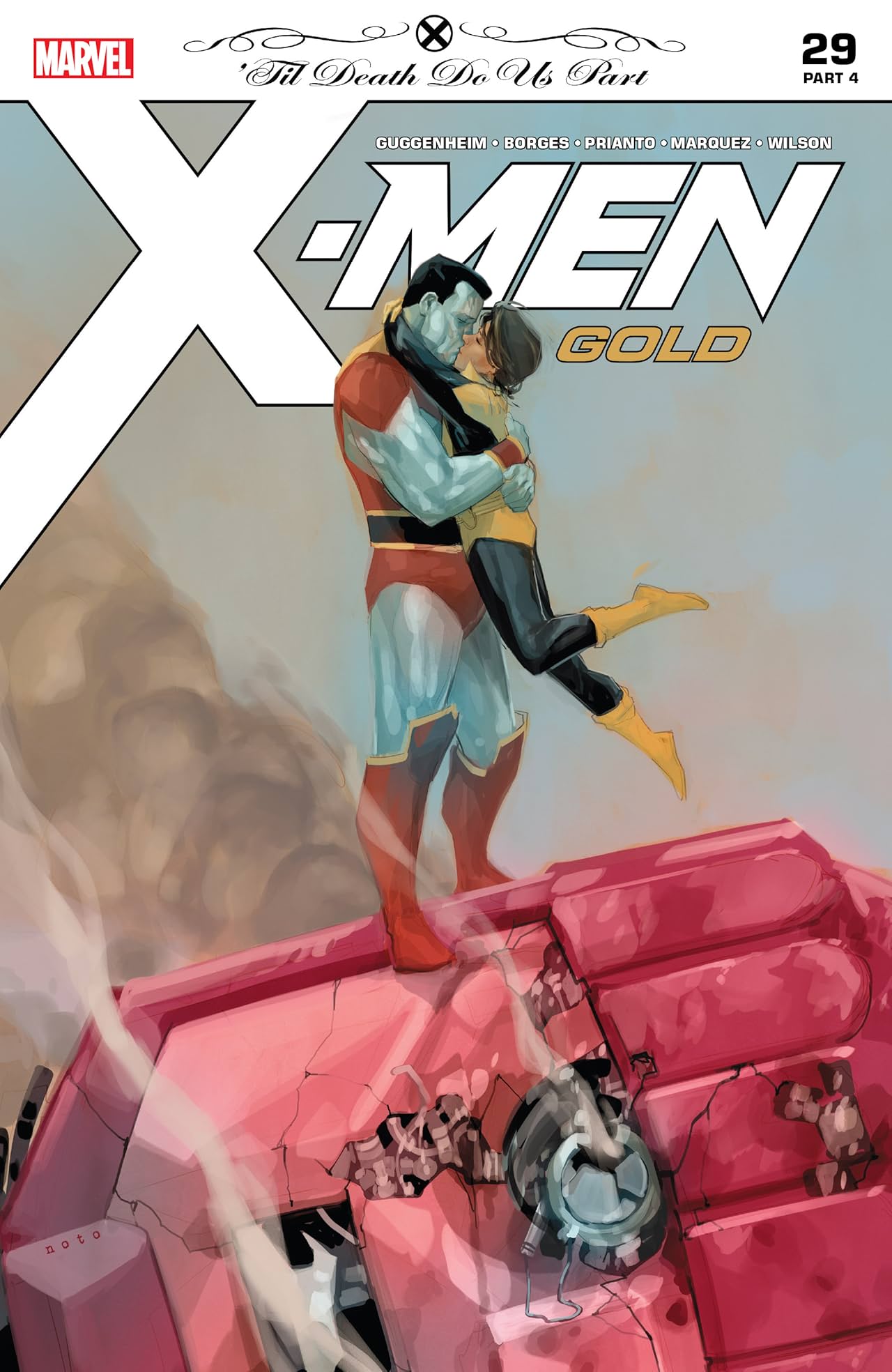
This has been a rough summer for fans of superhero comics, romance, and weddings. For a fan like me, this summer couldn’t have been rougher without adding a broken air conditioner to the mix. Between the depressing outcome in X-men Gold #30 and the disappointment in Batman #50, this summer has been a one-two punch to the heart.
While it’s pretty disheartening, I’m not totally discouraged. Being the admitted romantic I am, I believe love will eventually win out. I know that sounds corny and ripped right out of a Disney movie, but wouldn’t put so much energy into so many sexy love stories if that belief weren’t sincere.
Even so, I feel as though the current mood surrounding romance and superhero comics has a lot of room for improvement. Mr. and Mrs. X #1 was a good start, but only to a point. There’s only so much that I can do as a fan, aside from buying comics that depict quality romances with great sex appeal. Beyond that, my influence is limited.
As such, I’m going to take a moment from complaining about the current state of love in superhero comics and try a little exercise in romantic imagination. By that, I mean I’m going to contemplate the romantic potential of superheroes that will probably never cross paths, due to rights issues and belonging to different publishers.
It’s a sad fact of life and copyright laws that Marvel characters cannot interact with DC characters. However, that doesn’t mean certain characters don’t have romantic potential. In fact, I believe some have more potential than they do with anyone in their current continuity.
What follows is my personal list of the top six non-canon superhero couples. Not every couple on this list is a Marvel and DC character paired together, but given how many iconic characters those two companies control, it’s somewhat unavoidable. Also, please keep in mind that this is just my list. It is by no means definitive. This is just something meant to inject a little romance into a summer that badly needs it.
Number 6: Black Panther and Vixen

When it comes to healthy romance, it helps when two people share the same quirks. Whether that’s wine tasting or underwater basket weaving, having similar distinctions go a long way towards helping a couple thrive. It’s for that reason that I believe Black Panther and Vixen have the quirks/kinks to make a romance that’s both functional and sexy.
Black Panther’s star has risen quickly thanks to a billion-dollar movie, but his romantic history has been somewhat stagnant. His brief, but bland marriage to Storm of the X-men came off as a gimmick rather than a relationship. While he has chemistry with Nakia, it’s only the very general kind.
That’s where Mari “Vixen” MaCabe sets herself apart. Her powers, abilities, and personality is largely driven by her connection to animal spirits. It’s very similar to the connection that Black Panther has with Wakanda’s native deity, Bast. Being connected to animal spirits and having a fondness for jungle-themed costumes gives these two a unique connection that they haven’t had with their in-universe love interests.
I believe these two would complement each other in unique ways. Vixen is cunning and charismatic. Black Panther is strong and diplomatic. Alone, they’re both pretty strong. Together, they’re even stronger and much sexier.
Number 5: Dr. Strange and Zatanna

This is another instance of two people having shared interests, but with Dr. Strange and Zatanna, it goes deeper than that. These two are some of the most recognizable mystical characters in their respective worlds. Dr. Strange is the Sorcerer Supreme in Marvel and Zatanna is one of the most skilled magicians in the DC Universe. Together, their magic can be pretty potent, literally and figuratively.
However, it’s not just because of their mystical skills that I believe they would be good together. In their respective universes, both characters struggle to maintain even a semi-functional relationship. Zatanna often finds herself on the outside looking in with love interests like Batman and John Constantine. Dr. Strange has never had much of a love life outside Clea, who is almost always relegated to a supporting role.
Zatanna is not the kind of woman who is content with a supporting role. She’s someone who fights alongside Batman and the Justice League. She can handle the crazy mystical threats that Dr. Strange deals with on a regular basis.
For Dr. Strange, he finally has someone who can deal with his attitude and arrogance, which is a tough barrier for any potential love interest. Again, Zatanna dealt with Batman. Any woman who can deal with Batman has an edge. The fact she isn’t afraid to show her legs off and be a bit more playful with her magic also helps.
More than anything else, Zatanna is someone who could make a man like Dr. Strange smile while he works. That, in and of itself, is a kind of magic that helps any relationship.
Number 4: Batman and Sara Pezzini (Witchblade)

This one kind of breaks the mold because it doesn’t pair a Marvel character with a DC character. Sara Pezzini, also known as the bearer of the Witchblade, is not a Marvel character. She’s a product of Top Cow Productions. She comes from a very different world compared to Batman, but that world makes her uniquely equipped to handle being Batman’s lover.
Batman requires that a romance be complicated and prone to tragedy. Few women can handle that. While Catwoman came very close to making it official, it’s a testament to just how tortured Batman is in his love life, among other things.
For Sara Pezzini, that’s exactly the kind of man who brings out the best in her. Unlike Catwoman, Sara was never a thief. She’s a cop and a very dedicated cop. Throughout her long-running series, she defines herself as the kind of hard-nosed, tough-as-nails person who doesn’t hesitate to run into the crossfire of a gang war or a demon army.
Beyond just being a cop, Sara deals with far larger problems that come with being the bearer of the Witchblade, an ancient weapon that tends to attract insane threats, even by NYPD standards. Batman already deals with homicidal clowns and thugs who are half-crocodile. They can handle the craziness in each other’s lives.
More importantly, though, Sara can do something that so few women have ever done for Batman. She can complement him as both Bruce Wayne and Batman. As a cop, she can actually help Batman’s efforts to fight crime in Gotham. He can, in turn, help her deal with the supernatural horror shows that tend to follow her, as only Batman can.
On nearly every level, Batman and Sara Pezzini make each other better. They’re the kind of couple that can work together and be together. That kind of romantic combination is potent. Plus, Sara Pezzini’s hardened attitude might actually help Batman crack a smile every once in a while.
Number 3: Superman and Captain Marvel (Carol Danvers)

This is probably the most controversial pairing on this list because Superman has one of the most iconic romances of all time with Lois Lane. Carol “Captain Marvel” Danvers, on the other hand, has no relationships that even come close, even if you take into account her affair with alcohol.
The reason I believe these two would forge a powerful romance is because Carol Danvers embodies the best traits of both Lois Lane and Wonder Woman. She’s a skilled fighter like Wonder Woman, having trained in the military and fought in interstellar wars. She’s also uncompromising in her pursuit of truth, much like Lois Lane.
Beyond just having the best traits of two iconic women, Carol brings something else to the table. Unlike Superman, she wasn’t born with her powers. She got them in an accident that merged her DNA with that of an alien. At the heart of her story, she’s a human who becomes an alien. Superman, by contrast, is an alien who becomes human.
That unique dynamic, the struggle between being alien and human, is something that Superman has never been able to share with either Lois or Wonder Woman. Someone like Carol could both help him through that journey and fight by his side. She’s tough enough to go up against anything, be it a mad Titan or an evil super-genius billionaire.
Superman is, at heart, an ideal. He’s an icon because he sets an impossible standard for others to aspire. Carol Danvers defines herself by doing the impossible and fighting for it every step of the way. That shared struggle can create the kind of love that empowers two already powerful characters.
Number 2: Captain America and Wonder Woman

This one is probably the most logical pairing on this list. In fact, Captain America and Wonder Woman are probably the one instance where their potential is greater than that of any in-canon romance and it’s not just because their movies were so similar.
Captain America and Wonder Woman are ideal love interests because they both represent the best of their respective worlds. Captain America is the embodiment of the American spirit of freedom and justice, reality-warping retcons aside. Wonder Woman is the personification of womanhood, compassion, and a warrior’s spirit. They both set high standards and pride themselves on achieving them at every turn.
It’s a standard that Steve Trevor never achieves, despite being Wonder Woman’s primary love interest. With all due respect to him and Chris Pine, he’s not on Captain America’s level. In fact, Captain America is the kind of guy Steve Trevor aspires to be, but never achieves. That elevates him in terms of how he relates with Wonder Woman.
Beyond just showing Wonder Woman the best a man can be, Captain America can hold his own better in a drawn out battle. He may not have Wonder Woman’s level of powers, but he’s also a man who regularly fights alongside the likes of Thor and Hulk. He’s not just capable of working with demigods. He actually leads them. It’s easy to see why Wonder Woman would fall in love with a man like that.
On Wonder Woman’s side, she can do more than just punch the Red Skull harder than most women. She’s the kind of woman whose compassion and love of justice is second to none. Even though she’s not American, she embodies many of the American principles that Captain America champions. She may very well be the only woman he can love as much as his country.
Number 1: Deadpool and Harley Quinn

This one was a no-brainer. In terms of sheer sex appeal and romantic compatibility, Deadpool and Harley Quinn are in another league on top of being from different comic book worlds.
I don’t think I need to say much about Deadpool’s eccentric tastes in romance. Between his overtly raunchy movie and the fact he married a succubus in the comics, the man isn’t just attracted to crazy. It’s practically an omega-level fetish for him. In terms of crazy, sexy, and all the weird fetishes that go with it, Harley Quinn checks every box.
Beyond her fondness for clown makeup and obscenely short pants, Harley has always been defined by her love with madness. Love is what drove her into a world of villainy when she crosses paths with the Joker. While that relationship has many quirks, plenty of which are quite unhealthy, it shows that Harley loves men who aren’t bound by sanity.
Deadpool wouldn’t just fill her crazy quota and then some. He would offer her the healthy kind of crazy. He’s the kind of guy who reserves gratuitous violence to those who deserve it and that has been a major struggle for Harley for much of her history. He wouldn’t just be able to carry her through that struggle. He’d make her laugh just as much as the Joker and with only half the property damage.
Unlike the Joker or a succubus, Harley and Deadpool are also the kind of relationship that would have a level of sex appeal that is literally crazy. Beyond Harley’s love of skin-tight clothes and Deadpool’s “super penis,” these two would know how to have fun and blow things up, in and out of the bedroom. With these two, you never have to worry about things getting boring.
There you have it. That’s my list for the best non-canon comic book couples. I imagine this list will cause some disagreements. That’s okay and I welcome further debate on the issue. If you think there are other couples I should add to the list, please let me know. This is a rich and sexy topic that’s ripe for discussion.





:format(webp):no_upscale()/cdn.vox-cdn.com/uploads/chorus_asset/file/19290473/IMG_FA73493783F8_1.jpeg)





/arc-anglerfish-tgam-prod-tgam.s3.amazonaws.com/public/XR5X6MCWYJHRNNLIMW6UO6Q6MA.jpg)































